
Jungjin Lee, photography.
“I think the question of whether the theatre should adapt itself to the masses, or the masses to the theatre, has been settled once and for all. The masses only understood, or pretended to understand, the tragedies and comedies of ancient Greece because their stories were known to everybody and were explained over and over again in every play anyway and, as often as not, set out by a character in the prologue.”
Alfred Jarry (On the Futility of the Theatrical in Theatre, Mercure de France, September 1896.)
“The productive logic of film is the productive logic of the work of art in the twentieth century.”
Peter Osborne (in conversation with Paul Willemen in Working Together: Notes on British Film Collectives in the 1970s)
“The cultural heritage of humanity is regarded with suspicion. Its only interest lies in its “demystification”.”
Rene Girard (Violence and the Sacred)
“Humanity has but three great enemies: fever, famine and war; of these by far the greatest, by far the most terrible,is fever.”
William Osler ( lecture to the American Medical Association on “The Study of the Fevers of the South, 1896)
About eight years ago I quoted Hans-Thies Lehmann: “Defined in this way, culture also means renouncing certain nuances, possibilities and curiosities in order to present “l’énigme humaine dans sa maigreur essentielle” – “the human enigma in its essential bareness”. The ascendancy of “style” is based on renunciation: in exchange, the grandeur of tragedy dictates the rhythm of life. A certain elevation of culture – that is, of style – is required for society to “deserve” tragedy, as it were.”
Hans-Thies Lehmann (Tragedy and Dramatic Theatre)
That was only part of a longer quote. But I’ve been struck recently by the absence of tragedy, and more, by the absence of an avant garde. And its curious that the avant garde has in fact disappeared. One of the things that the Covid event has demonstrated is that the destruction of art and culture has been planned and worked on for decades already. And it is worth reflecting again on some of the Frankfurt School’s notes regarding the erosion of mimetic capacity.
“There is, however, a flaw in Odysseus’s strategy. And it becomes the “germ cell” (out of which the dialectic of enlightenment unfolds. Although it is not directed outwardly, the renunciation of inner nature that“ man celebrates onhimself” is no less a sacrificial act than the ritual immolation of a bleating lamb. As sacrifice,it remains subject to the law of equivalence. A price must be paid for Odysseus’s survival, that is, for victory over the dangers posed by external nature. That price is the reification of the self. Insofar as the ego distances itself from its archaic prehistory and unconscious-instinctual life, in one sense, it looses its mimetic relation to theworld. In another, perverted sense however, mimesis is preserved in the process, for an objectified self mimics the reified world it has objectified.”
Joel Whitebook (The Marriage of Marx and Freud: Psychoanalysis and the Frankfurt School)
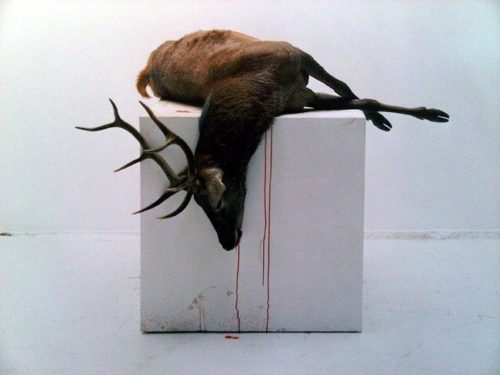
Eric Poitevin, photography.
“Men had to do fearful things to themselves before the self, the identical purposive, and virile nature of man was formed, and something of that recurs in every childhood.”
Horkheimer & Adorno (Dialectic of Enlightenment)
The short version of Horkheimer and Adorno’s notions of the Enlightenment’s fatal flaw was that , as Whitebook writes…“the whole process of ego formation, and hence the project of enlightenment, is self-defeating. It systematically eliminates the possibility of achieving its own goal.Enlightened thinking reduces the ego’s function to the biological activity of self-preservation – “mere life” in Aristotle’s sense – and the sacrifice of inner nature makes a fulfilled life impossible.”
The repression of fantasy and by extension creativity was to mark the beginning of the assault on what is human.
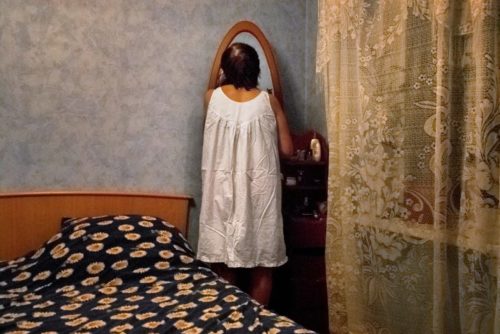
Bieke Depoorter, photography.
The attack on childhood seen in the Covid policies regards schools and social distancing is the perfect example of a tendency active for thirty or forty years. Play was to be regulated, in the name of safety. Of risk management. Life was modeled on economic logic. Adorno was later in life even more skeptical of overcoming the impasse of critical thinking and discernment set against the loss of instinctual inner life. Any attempt at a more human existence under Capitalism was a false reconciliation with an unreconcilable world.
What I see today in the public displays of mask wearing is a submission to both authority, but also a submission and acceptance of the barren inner life of Capitalism. Additionally, it is a regression to something nearly exactly like witch burning and belief in the evil eye.
“…it was not until 1774 that parliamentary investigations into such improper confinements resulted in the Madhouses Act, which required these businesses to become licensed and inspected by the Royal College of Physicians. A strict eye needed to be kept on “gaolers of the mind, for if they do not find a patient mad, their “oppressive tyranny makes him so.”
George Makari (Soul Machine: The Invention of the Modern Mind)

Odili Donald Odita
Whenever I question the Corona event I usually hear one of several responses. The most common, by far, is “but what about all those dead people?”. It is an admittance of denial about death. People die every day. All over the world. It is the fate of everyone. Even Elon Musk. And a society that hides itself from death, institutionally and ideologically, is going to be one that eradicates art and culture, creativity and fantasy.
“Like Wittgenstein’s logic, poiēsis – the poetic – doesn’t give a picture: it is foremost structure and situation. Poiēsis (and by declensions a radical genre of poetry not instituted by any sort of Platonistic gesture), operates across all modes of discourse – including the technical and even mathematical. It internalises its dichotomies in advance, so that to speak of “poetic language” is at once to stipulate a general condition of the signifiable, while at the same time evoking a fundamental aporia, paradox, or pleonasm. The “impossibility of the possible” and the “possible of the impossible.””
Louis Armand (The Organ Grinder’s Monkey)
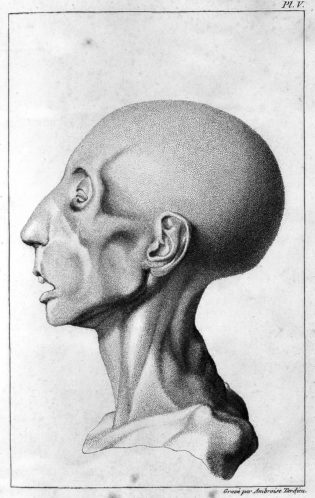
Insane patient at a French asylum.
Ambroise Tardieu (Des Maladies Mentales) 1838 engraving.
human consciousness. Writing establishes what has been called ‘context-free’ language (Hirsch 1977, pp. 21–3, 26) or ‘autonomous’ discourse (Olson 1980a), discourse which cannot be directly questioned or contested as oral speech can be because written discourse has been detached from its author. Oral cultures know a kind of autonomous discourse in fixed ritual formulas (Olson 1980a, pp. 187–94; Chafe 1982),as well as in vatic sayings or prophesies, for which the utterer himself or herself is considered only the channel, not the source.The Delphic oracle was not responsible for her oracular utterances, for they were held to be the voice of the god. Writing, and even more print, has some of this vatic quality. Like the oracle or the prophet, the book relays an utterance from a source, the one who really ‘said’ or wrote the book. The author might be challenged if only he or she could be reached, but the author cannot be reached in any book. There is no way directly to refute a text.”
Walter Ong (Orality and Literacy: The Technologizing of the Word)

Hervé Télémaque
Post WW2 saw an explosion in American arts, and unlike the post WW1 era, or the period of the late 19th century, the post WW2 era was interdisciplinary and drew from Europe (if only or mostly in the guise of immigrant talent). Black Mountain College saw Charles Olson take over as rector in 51 I believe, but he had already had a huge influence there. And Olson mentioned the years 1947 and 1948 in lectures and the importance of abstract expressionism for poets and, really, all the arts. And he saw Pollock and Kline (in particular) as significant for poets specifically, for it was Kline who conjured the page, and for the Projective Verse followers of Olson this was impossibly important. In film, 47 is probably the greatest single year for American film, unless you think 48 and 49 and maybe 51. This was the golden age of film noir, and the work of directors like Robert Siodmak and Fritz Lang, and Jacques Tourneur, as well as Orson Welles and Billy Wilder, Hitchcock and Sirk, Phil Karlson and Edgar Ulmer, defined an alternative master narrative for America. Olson knew well the godfather for American arts was Melville. It was never Whitman or Twain, though both have virtues, but Melville who wrote the cosmology for the Americas.

Dorothy Napangardi
Both Black Mountain College and The Bauhaus were anti-institutional institutions. Both hired artists, regardless of institutional credentials. Both carried a vision of a better society in their choices of instructors, and in their curriculum. Today, as the Covid drama plays out, a drama of kitsch emotions and junk science, a drama of ruling class arrogance and a drama, most of all, about the surrender of all skepticism and credulity, the collapse of culture seems nearly complete. This is not to say terrific artists are not out there making art, because they are, but that the context for art has eroded to nearly nothing. And now the cunning of Covid has allowed a messianic billionaire class to influence the flunky governments of the planet (and really to convince, often, sane governments) that they must hammer that final coffin nail on art rituals and ceremonies.
“…the entire oral noetic world relies heavily, even fundamentally, on copying not just nature but oral utterance itself in its management of knowledge. Oral cultures preserve their articulated knowledge by constantly repeating the fixed sayings and formulas-including epithets,standard parallelisms and oppositions, kennings, set phrases, and all sorts of other mnemonic or recall devices in which their knowledge is couched. Oral noetics enforce the copying of human productions as well as of nature. Copying becomes an overwhelming and preemptive state of mind. Even storytelling, which would seem to derive necessarily from external events as such occurring in unpredictable sequences calling for unique statement-for is it not the unpredictability which makes history history and makes a story interesting?-is managed in oral cultures chiefly by stringing together preexistent, imitable formulary elements-in however intricately managed patterns. Mimetic ideas of art are based on acceptance of copying as a primary human enterprise. “
Walter J. Ong (Interfaces of the Word : Studies in the Evolution of Consciousness and Culture)

Gilles Aillaud
As mimetic capacity has decreased over time, and as children’s spontaneous play is increasingly supervised and regulated, the artistic engagement with mimetic process is being lost. Children’s toys even make the sounds children once were allowed to create for themselves (truck engine growls, and fierce tiger growls, or even the running commentary on a fantasy sports event). In theatre, where repetition is so important, the instrumental logic of performance today has discouraged the important aspects of repetition. Now there is a difference between the compulsion to repeat and repetition and some of this lies in the evolution of Freud’s own thought on this topic. But it is important not to lose the attachment of trauma to repetition — for this is the compulsive aspect, but I suspect this is present in some degree in all repetitions.
“The yield of pleasure on playing games, then,is proportional to the amount of psychical release, and obstacles make sense only insofar as they increase the psychical tension and potential for its release. The analog of games Freud has in mind is that of foreplay prior to sexual intercourse.For adults, with maturation and strengthening of the critical faculty, reality takes center stage,and play, the emissary of the inner world, has a diminished role in adult life. Thus, the rediscovery of what is familiar ceases to have the bang for adults that it has for children. Yet, despite appearances, adults cannot give up play, for no source of pleasure is ever renounced. Adult play is,then, an effort to repeat the pleasure of childhood by finding a suitable substitute that does note licit the censures of fellow adults . Thus, adults’ play is a substitutive form of repetition. One has only to reflect on the role of playful sexuality in adults to multiply examples. Later in the same work, Freud expands his analysis of children’s games. Their games typically involve another form of repetition *mimicry* i.e., observation and replication of adult’s behavior. Mimicry of adults’ situations, Freud says, is a child’s ‘best art’ and what motivates most of his games. Mimicry of children’s situations is also a form of comic ‘degradation’ for adults and a source of pleasure for children. This relief, which gives the child pure pleasure, becomes in adults, in the form of degradation, a means of making things comic and a source of comic pleasure. “
Mark Holowchak and Michael Lavin (Beyond the Death Drive: The future of “Repetition” and “Compulsion to Repeat in psychopathogy”)
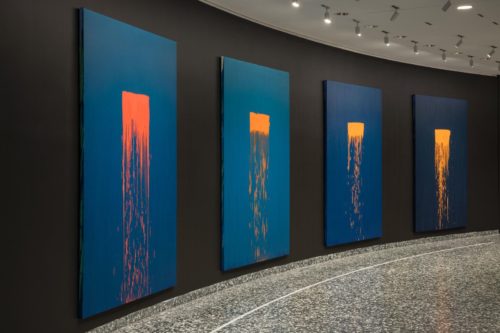
Pat Steir
Repetitions are also a normal part of sexual development and adult practice, from thumb sucking to masturbation.Now, there is another aspect to the mediation of repetition and that is the quality of cathexis, if we want to be psychoanalytical about it. A corrupted libidinal force is both diffuse and overly obsessive — but my sense is that the obsessive is now disengaged in a sense. Alienated obsession, and here again the issue of context is introduced.
“Mnemonic patterns, patterns of repetition, copyings, are not added to the thought of oral cultures. They are what the thought consists in. Since we know only what we can recall, an oral culture must think readily recallable thoughts, mnemonically cast thoughts, or it might as well not be thinking, for it will never be able to retrieve what it has once thought. Unless it thinks in mnemonic patterns, an oral culture is only daydreaming: verbalization that passes through consciousness in non mnemonic patterns tends to drift away. Education which is oral or residually oral thus trains pupils in copying, in mastering cliches-which writing and print would downgrade and even attempt to outlaw.”
Walter J. Ong (Interfaces of the Word : Studies in the Evolution of Consciousness and Culture)
“Globalization entails that people become increasingly alike;they wear the same athletic gear, watch the same shows, buy the same stuff. The malls in Dubai and Denver look similar. We live in age of Google, Facebook and Apple. Diversity may be the slogan of the moment, but uniformity is the reality.”
Russell Jacoby (Publishing My Book on Diversity, 2019)
Responses to anyone questioning the Covid consensus are, as I say, relatively uniform. The speakers/writers wax indignant, claim great passion and anger, and yet one feels none of that. The sound of it reads hollow. One feels uniformity in obedience to the consensus, even if the tract followed to arrive at that consensus was varied. Some, perhaps many, I have engaged with simply don’t read much. Its likely they absorb TV and screen news on their tablets or laptops. Another group does read more, and because of that are defensive and snarky. Literally nobody who actually has researched the reality of this mass propaganda apparatus and project think the mainstream narrative is true. I have not met one.

Stefan a Wengen
“…postmodernism is the institutionalisation of the avant-garde.”
David Lehman (The Last Avant Garde)
The constant drum beat of fear is the new expression of superstition. Instead of amulets or totems there is the ephemeral (and endlessly repeated !) litany of statistics and expert testimony. The Covid test is exactly as reliable as throwing salt over your left shoulder. It is pure superstition and magical thinking. Couple that with a prevailing innumeracy in the general public, and what is left, after the obvious cognitive decline in western society, is the bare naked structures of individual trauma. The most clarity is found at the level of the working class today, a class acutely aware of the desperate straights into which they have been thrown, and a class that has devised strategies to deal with the violence the state visits upon them.
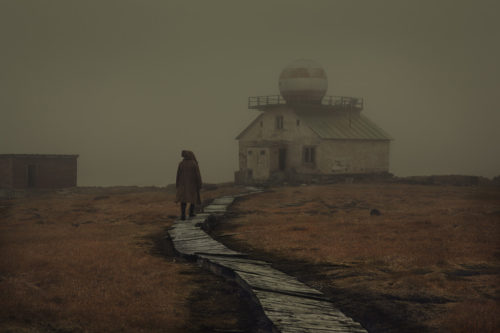
Evgenia Arbugaeva, photography.(Abandoned observatory, Kotelniy island )
The building blocks of creativity have been rendered opaque. The mimetic empathic engagement with the material world is replaced with screen experience, an experience today that cannot even substitute storytelling for some form of childhood fantasy, for storytelling is largely disappearing. The formulaic aspect of mainstream and studio screen product is a postmodern (sic) form of repetition. A repetition that is untethered from memory. It is auto-repeat and while trauma is intrinsic, it is also generalized. It is, actually, the exact opposite of the repetitive patternings of an oral culture. The post literate society is one which closely resembles the world of young children before they learn to speak.
“After a century-and-a half, the avant-garde’s principle legacy, it seems, is its own disappearance: a vanishing act corresponding to a type of rectified perturbation in the system of western historical consciousness. Hence, Debeljak writes, “while liberal bourgeois individualism implied the provinces of privacy, self-development, dignity, and autonomy, the emerging form of the individual self in advanced capitalism is instead articulated in terms of fragmented and narcissistic consciousness.” And all of this not because the avant-garde was driven from the streets, like the once ubiquitous organ-grinder, but because it’d long ago learned to convert its radical currency into a mix of public sinecure and private hedgefund, and in the process turned from antitype of social conformity into conformity’s very safe-guard. “
Louis Armand (ibid)

Gerard Fromanger
As Armand notes later, the pseudo cultural conformity ( real though it may be) masks an ethical inequivalence and global (increasingly so anyway) system of rigid class hierarchies that are, when even noticed, defined as their opposite — as Armand writes… “viewed through the prism of a western cultural apparatus that’s increasingly come to be a functional ambiguity: an ambiguity which anticipates and incorporates, in advance, its own critique and thereby affects a type of law unto itself.”
Covid is then the law, an inevitability of history, and resistance is therefore futile. Despite clear and simple summations, such as these here https://swprs.org/a-swiss-doctor-on-covid-19/?fbclid=IwAR1gn2Zm0TR_mQcAKE4e_Z_gpUg-O2OBiHOZf_dO-6Yxr58T3g-GcFvXhBk#latest
and a dozen articles in Off Guardian on the subject, the flagship paper of the U.S.( N.Y. Times) continues to hawk the threat with emphasis on increasing numbers of those infected (not deaths, of course). The public in general ignore experts who don’t fit the narrative https://www.stanforddaily.com/2020/05/04/qa-nobel-laureate-says-covid-19-curve-could-be-naturally-self-flattening/
The numbers though, in fact, are far from trustworthy. The WHO or CDC could say anything and who could refute it. They are “experts” of the consensus building variety. They are institutional authority, they are largely like government.

Carl Holsøe
The wearing of masks is clearly linked to a denial of death, and it serves as a kind of ceremony. A faux heroism of the sort Becker outlined fifty years ago.
“The first thing we have to do with heroism is to lay bare its underside, show what gives human heroics its specific nature and impetus. Here we introduce directly one of the great rediscoveries of modem thought: that of all things that move man, one of the principal ones is his terror of death.”
Ernest Becker (Denial of Death)
But perhaps above all else, save the relatively more superficial virtue signaling, the mask fetish is about dreams of eternal life, and perhaps something like personal purification. It is also, simply, a symbolic muzzle. Also, tied into the denial of death that drives some of this “heroism” is the general fear of germs that exists in the West. And the fear of germs is tied into a sexual negativity and misogyny that has a long durable history in the West.

Braque Family Triptych, closed. Rogier Van der Weyden, 1452.
That fear of the unclean and invisible is a perfectly Puritanical theistic subtext, here. The moist and warm is both being shielded by masks, but also created. If ever a symbol was overdetermined it is the surgical mask as protector from the plague.
“The word “autism epidemic” permeates news stories, articles, websites, literature and conversation about autism. Within this discourse exists a psychology;the human response to epidemics, whether it is perceived or real. Stigma,moralizing, panic, calls for a cure and looking for an explanation are just some of thereactions humans have historically had towards epidemic disease. Although autism is not an epidemic disease, much of the narrative and discourse around it functionsas if it were one.”
Kate Corbett Pollack (The Perceived Autism “Epidemic”: Epidemic Psychology Evidenced in Autism Narratives and Discourse)

Rogier Van der Weyden, 1452. Braque Family Triptych, open.
Cutting across the fetishized responses to Covid is a tradition of American anti intellectualism.
“The more learned and witty you bee, the more fit to act for Satan will you bee if the Lord leave you.”
John Cotton, (Puritan Minister, 1642)
The loss of mimetic ability, of mimetic experience and the compulsive repetition of generalized fears, of fears that are often tied to marketing and state propaganda, though hardly always, and the overall loss of the past, of memory, are all intwined actively in the Covid narrative. The background story is one of ruling class plunder and a further intensifying immiseration of the working and underclass. The narrative for the educated 30% that Chomsky once spoke of, and in this case a largely white American bourgeoisie that is clinging to their rung on the ladder of social success, is a story of surfacing terrors and irrational acting out. Its positively Hegelian. The virus is not special, not unique (novel!) but pretty ordinary albeit not imaginary, but the multi layered story of the Spectacle in times of pestilence IS rather remarkable.
Of course the great “reset” that everyone from Prince Charles to Kissinger are giving interviews about is linked to the plunder narrative. But this is only possible because of the activated fears of a white class whose privilege has been slipping away for decades, now.

Steven Gregory (photo C. Bedworth).
Stigmatizing the unmasked feels almost premodern.
“Mythology itself set off the unending process of enlightenment in which ever and again, with the inevitability of necessity, every specific theoretic view succumbs to destructive criticism that it is only belief, until even the very notion of spirit, of truth and, indeed, enlightenment itself have become animistic magic.”
Horkheimer and Adorno (Dialectic of Enlightenment)
“It was now, as I said before, the people had cast off all apprehensions, and that too fast; indeed we were no more afraid now to pass by a man with a white cap upon his head, or with a doth wrapt round his neck, or with his leg limping, occasioned by the sores in his groin, all which were frightful to the last degree, but the week before. But now the street was full of them, and these poor recovering creatures, give them their due, appeared very sensible of their unexpected deliverance; and I should wrong them very much if I should not acknowledge that I believe many of them were really thankful. But I must own that, for the generality of the people, it might too justly be said of them as was said of the children of Israel after their being delivered from the host of Pharaoh, when they passed the Red Sea, and looked back and saw the Egyptians overwhelmed in the water: viz., that they sang His praise, but they soon forgot His works.”
Daniel DeFoe (Journal of a Plague Year)

Lewis Baltz, photography.
* a sort of footnote. Films released in 1947..Out of the Past (Jacques Tourneur), Dead Reckoning (John Cromwell), Lady From Shanghai (Orson Welles), Boomerang (Elia Kazan), Daisy Kenyon (Otto Preminger), Lady in the Lake (Robert Montgomery), Odd Man Out (Carol Reed), Brute Force (Jules Dassin), The Ghost and Mrs Muir (Joseph L. Mankiewicz), Monsieur Verdoux (Charlie Chaplin), Dark Passage (Delmar Daves), Born to Kill (Robert Wise), The Fugitive (John Ford), Gentlemen’s Agreement (Elia Kazan), Johnny O Clock (Robert Rossen), Pursued (Raoul Walsh).
To donate to this blog use the paypal button at the top. Donations also go to cover costs for Aesthetic Resistance at Soundcloud https://soundcloud.com/aestheticresistance

On Masks…
Another metaphor to add to the list of “purification,” “muzzle,” and “eternal life,” is separation. A mask becomes a barrier, a wall. It slows down the passage of air; some masks even reduce the intake of oxygen to the body. This is a separation, not only from human-to-human, but a deeper separation from the trees and plants (the earth), and from the mysterious and wondrous exchange of breath and particles inhaled and exhaled from beings alive and, now, dead. The air connects us with each other, our past, and our future: intensifying existence into a present inhale and exhale. It makes our “insides” outside and our outside, inside. I see masks as metaphorically dividing us from each other, the earth, and from remembering….from history. Next to this is a loud cry to not forget, for instance, with the Black Lives Matter movement. We have the masks and other currents unmasking…
Back to the “separation” metaphor….Masks create this false narrative of separation and seem to strive to make us forget our actual state of deep inter-connectivity. This is related to that popular narrative, you mention above, that people are unique because they can choose between wearing one brand of shoes over another, when really, each person is playing out the same pattern of a consumer narrative, whether it is a mall in Detroit or Dubai. Because our inter-connectedness is real and true, the mask as separation is yet another illusion. It may slow down the exchange of air and particles from outside to inside, yet it will still happen. And in this lies the crux of the matter: redistribution of resources and dismantling of these exaggerated class hierarchies. You need the docile, unquestioning acceptance of the masses to follow the authority made by a minority of people (i.e. wear a mask), to keep the status quo of current power relations in order. The balance can turn at any moment. When the people realize they have choice and have the courage to make those choices, the dominant narrative and power structure will begin to fail. There are already signs that it is.
That being said, I have noticed an attitude of mask-wearing that strikes me as related to the “denial of death” you speak of. A few times I have been on walks and have noticed young teens all dressed up and wearing masks almost like part of their fashion statement. There is a sense as I see these vital, young, chattering teenage bodies pass by, that they have donned their mask like a pair of sunglasses or a hair piece–unconscious of the horror of the thing. Do these folks experience what I experience when I put one on? That sense of being suffocated and inhaling something stale and moist and putrid and, in fact, rather dead?
On Ceremony, Ritual, and Children’s Creative Play….
“the collapse of culture seems nearly complete…..And now the cunning of Covid has allowed a messianic billionaire class to influence the flunky governments of the planet (and really to convince, often, sane governments) that they must hammer that final coffin nail on art rituals and ceremonies.”
I, personally, have found this covid/lock down period to have been a time of increased ritual activity in my own life. I won’t go as far as to say whether it is “art” but ceremony, ritual, yes.
This June was my PhD convocation. For me, it was not only the convocation of my PhD but an end of an era in my life spent in academia. My university institution offered a digital, pre-recorded convocation and a “digital diploma.” They sent me about 50 emails over and over again telling me how great my digital diploma was and how I must “be sure to download the app” so I could get my digital diploma. With each email I deleted, I’d get another one reminding me how great the digital diploma was and whether I’d downloaded it yet(!?), etc. Not sure why the fuck I should care, I tried to download it, wondering if there was some deeper sort of meaning to this deluge of emails than the superficially obvious. Upon trying to download the app, I discovered that only people with smart phones can download a digital diploma. I do not have a smart phone, or any cellphone and I never have. I suppose that was the deeper meaning….
I’ve never been to one of my convocations before and certainly was not interested in their digital version. That being said, for me, there was something rather important about commemorating my time spent in the academic institution and how far I had come in my own personal growth and discovery during that time. My story of my relationship with academia is, decidedly, not exactly typical and was, in fact, fraught with a much deeper struggle between freedom from rules and authority than a middle/upper class social hazing event, or consumption of knowledge or skill-training or accumulation of accolades or romantic intellectual pursuit of great questions, as we often think.
This June, I decided to create my own convocation ceremony, like a funeral rite to lay to rest that era and invite in the new. I planned it on a very particular night based on ancient Chinese teachings and astrology lore about significance around cycles in nature and what they mean in terms of “endings” and ‘beginnings.” The ceremony was performed outside of the city in a large arboretum surrounded by woods at the site of a round-about where two paved roads meet at a sort of parking area for hikers. I brought one friend with me as witness, and otherwise, it was the animals, trees and sky that saw the event take place and those few who have heard the story of it afterward, or seen traces of it left.
I and my friend walked to the arboretum (about 35 minute walk) in complete silence. We split off at the entrance to the arboretum and I gave him specific instructions for where to go, where to sit, and when to leave the ritual space after the ceremony. I left him to find his place near the round about and I went into the woods where I put on my “white whale costume”–a metaphor for Moby Dick consisting, essentially, of a simple, yet substantially skirted vintage 1950’s wedding dress with a hospital gown over it, an old hospital bracelet around my wrist, and a necklace with a pearl.
I dressed and stood alone, at the edge of the section of woods, facing the wide-open arboretum, surrounded by forest. The traffic circle is at the far end of the arboretum (where my friend was positioned, too far to be visible at dusk), and where I stood, I was at the other. When the first star came out, I took that as my cue to cross the open field to the circle where I performed a simple act of leaving a memorized inscription on the pavement in white chalk. (This was significant for me as I did a massive 6 months worth of anonymous chalk drawing across the university campus one summer during my PhD as part of my search for the white whale).
Despite not drawing with chalk regularly since that six months in 2016, I found during the ritual, in the silence of the arboretum and surrounding woods and gathering darkness, that I had not lost my uncanny ability to assess a large swath of pavement and properly estimate exactly where to start and where to finish and how big to make my inscriptions in order to fill the space in an exactly balanced way without running out of the store of chalk I had brought. There was something very haunting and effortless about the simplicity of this whole event and how very quiet my mind was during the whole thing, as though I was simply listening to guidance that was fully inspired and true. I’m not sure what I looked like from the outside (I never asked my friend who watched). I felt, in my white wedding dress and hospital gown, like a ghost trailing across the vast lawn of the arboretum, or a witch, or a woman locked up as “mad” and escaped from the asylum. I felt that the whole scene was watching me….participating with me. I remember the utter joy and strength of my confidence in what I was doing (even though it might seem absurd to anyone doing a conventional convocation), as I ended my walk across the vast lawn and stood at the traffic circle, assessing the pavement before me, and the surety i felt in that simple knowing of where to kneel down and strike out the first letter upon the pavement and how as soon as I knelt down and heard the scrape of chalk, I was in my power. The white whale chalk drawing in 2016 had been many things to many people. What this convocation ceremony brought back to me was the sense of deep peace and connection with the land and the quietness that I experienced in 2016 when covering the pavement in Moby Dick quotes and drawings of white whales late at night or at dawn on the university campus when no one was around.
After writing the inscription (Not Moby Dick related, only the form was similar to that previous chalk project, not, obviously, the content), I read over what I had written, and then removed the hospital gown and hospital bracelet and tossed them on the pavement. Freeing myself from the academic institution also meant freeing myself from the medical one. I returned across the lawn in my white vintage wedding gown to the trail head at the end of the woods where I had left my everyday clothes in a paper bag.
That week, post ritual, we had two heavy rainfalls. One very heavy rainfall and another steady but less heavy rainfall for a fairly long period of time. As the rain fell, I imagined the water carrying away the chalk inscription on the pavement and washing that space clean and new for the next beginning. 8 Days after the ceremony and those two rainfalls, I returned to the arboretum to look at the spot. As I approached, I noticed two swathes of white, hovering and ghost-like upon the surface of the road. I felt a sudden, creeping feeling of shock and wonder and the eerie sense that I had, indeed, done something more than mere child’s play at costumes and chalk drawing (I’m intentionally relating this performance/ritual/ceremony to “child’s play” in connection with what you wrote above about what seems like the effort of contemporary society to prevent children from playing and using their imagination). As I approached, I saw that these two marks were the inscriptions of two hexagrams I had drawn on the pavement that I had taken from the I CHING. I was also shocked to note that the words I had written were, though a bit faded, still quite clear enough to read with ease. Out in the open, under the sky, they really should have washed off. There had, indeed, been rainfall at the park for only 10 feet away at a dip in the pavement lay a long, stagnant puddle. This discovery seemed to validate the niggling feeling I had since the ceremony that I had done something quite beyond my little human pre-frontal cortex’s capacity to understand. I did, again, have that uncanny sense that the land had been participating somehow. The land is a great audience….we might learn something from it about how to be an audience for the theatre.
Was I drugged when I did that? No. Am I mad? Have I thoroughly surrendered to child-like imagination? Have I been playing out a child’s make-believe story of the witch who walks out of the woods and makes hexes with her charmed sticks of chalk on the road? Have I surrendered to a deep meditative state? Have I actually tapped into a “higher consciousness” akin to what the shamans are aware of? Have I created a sense of these things simply through the execution of a very specific and deliberate ceremonial performance? Could that ceremony qualify as “art” even though I did not get paid, only had one human live presence during the act of it, and have no idea who has come across the inscription since or what they thought of it? Could it be all of these things? Or…
To me, it was a simple act that signified the end (or death) of one era and the beginning of another. It had no “meaning” or obvious outcome, nor was there a clear instrumental effect I hoped to get from doing the thing. I mean, who cares? I didn’t make an argument or outright statement about current events. I didn’t post on social media or take pictures. It didn’t go in the news. Only one person saw me do it. It’s anyone’s guess how many people found and bothered to read the inscription left in that clearing in the woods. Who cares? Why does it even matter? What does it do? It doesn’t bulk up my resume or CV or get me a job or get me money or get me that smart phone or whatever else authority wants us to value these days.
And yet….the rain didn’t wash it away.
“Another group does read more, and because of that are defensive and snarky.”
Yes. And that group is almost universally the salary class.
The working class people that I have spoken to are either bewildered or can see that this is a bunch of nonsense. But the salary class, the ones who have unquestioningly consumed all the media and taken it all at face value, are now true believers in a kind of religious cult. I have tried to speak to some of them to at least get them questioning the official narrative and they physically recoil from any discussion. They display a physical fight or flight response at the very idea that things are not as they are portrayed.
You mention that the salary class is terrified of losing their position. Where I live, in the last few decades there has been massive real estate inflation, overcrowding of public transport, overcrowding in offices and a general deterioration of living standards. But, we called this ‘economic growth’ when, of course, it is really just inflation. The salary class have benefited the most from globalisation but that trend is now coming to an end and I think they can instinctively feel that it’s now their turn to take an economic haircut and they don’t like that idea one bit. The masks are also an instinctive protection against the fate that awaits them. And a vaccine? Sure. Just give me anything as long as I don’t lose my social status.
“The most clarity is found at the level of the working class today, a class acutely aware of the desperate straights into which they have been thrown, and a class that has devised strategies to deal with the violence the state visits upon them.”
That sentence is striking and it is the key; it chimes with what I’ve observed over the decades: to be really very hoodwinked, in a clever way, one first needs a certain amount of education.
agreed
Hi John, Please find an interesting perspective on the Covid mind virus and its relation to the Wetiko Disease via this reference:
http://www.awakeninthedream.com/articles/covid-19-wetiko
thanks
https://jonjost.wordpress.com/2020/04/01/the-corona-conspiracy-a-fable/
https://jonjost.wordpress.com/2020/05/05/the-corona-conspiracy-2-a-fable/
There has been plenty of analysis on the social aspects of the scam. Such as Truthstream Media’s little video on masks and ritual. Of course there is virtue signaling and obeying (aka. Social Credit Score). There is other aspects, such as a person pulling up their mask when they see you even though they are walking with another person and not having their mask up. Or like when your walking out on a park trail and they move over to the side, face the woods and keep their back to you. All these actions being very offensive and shunning. I find that women are the most susceptible to this action. And we have the technical aspects. Degrading your oxygen levels and creating an environment of toxicity you are breathing in. People putting the masks on children even when they actively playing. And we have economic exclusion. Forcing you to where a mask to even go into a grocery store. All of this illegal in a system outside the rule of law.
The problem is people. None of this could happen if not for the moral corruption of people. For many of them are aware of the lies and nonsense but go along with it to “provide for their family” or take one for the team. And while doing so, trampling all over the rights of the fellow individual. A simple example being an employer forcing employees to where masks and saying we have no choice if we want to work. There always a choice. The choice to say no. If you can’t say no you aren’t a free individual. Enough people saying no is the restoration of free choice.
I would suggest looking into William Engdahl and his writings if you haven’t. I personally think that a big part of this opp, if not the biggest, is the total decoupling of the China economy from Anglo nations before they attack China in a hot war. Possibly by proxy. If you look at the Chinese investment in the US for areas such as industrial production & processing, energy, commercial real estate, insurance investment companies, Hollywood, etc., these areas have taken a loss under the lockdown. San Francisco, LA, NYC, Chicago, and Texas had some of the highest investment. These are all cities that are being targeted the heaviest right now. There is a mass exodus of people leaving NY, LA, San Francisco, and Chicago. Tele-work mandates keep people out of office buildings. Smithfield foods closing down was an attack on a Chinese owned business. A lot of the factory farm operations exported to China and Asia. The Antifa/BLM are intelligence agency assets espousing Communist propaganda. Committing violent acts. Destroying culture and history. The “virus” is called the China Virus. China is always called Communist China. This is all propaganda to make the public hate China and anything related to Communism ( of which the controllers and perpetrators of this narrative believe in pure collectivism/ technocratic fascism). You’ll find that a lot of the Twitter posts, video evidence, and other “proof” is faked or not even of the event described. Plausible deniability if caught(aka. Fake News Syndrome)? Whitney Webb has done a lot of great work uncovering things and the Shadowgate video, although biased, does show the range of tools of manipulation available and how they are used.
My concern is of William Engdahl’s latest post which fears that the goal is a war that destroys both the US and China and destroys the sovereignty of both nations, handing it over to the Great Reset crowd. If you look at Scott Atlas being a member of the Hoover Institute (focuses on China and Russia), during an engineered depression, with Condoliza Rice taking over the institute in September, and Stanford University coming into spotlight, the symbolism is blatant. Even from the beginning, this happening in the year 2020 (as in 20:20 vision) is just amazing on how blatant the coded language is on all of this. Also the number 33.
So I guess we wait and see, as it seems the public doesn’t give shit.
As far as culture, well, I give you the lyrics from the KMFDM song DOGMA.
All we want is a head-rush
All we want is to get out of our skin for a while
We have nothing to lose because we don’t have anything
Anything we want anyway…
We used to hate people
Now we just make fun of them
It’s more effective that way
We don’t live
We just scratch on, day to day
With nothing but matchbooks and sarcasm in our pockets
And all we are waiting for is for something worth waiting for
Let’s admit America gets the celebrities we deserve
Let’s stop saying, “Don’t quote me” because if no one quotes you
You probably haven’t said a thing worth saying
(Sex, drugs, God, cash
Sex, drugs, God… America)
We need something to kill the pain of all that nothing inside
We all just want to die a little bit
We fear that pop-culture is the only kind
Of culture we’re ever going to have
We want to stop reading magazines
Stop watching TV
Stop caring about Hollywood
But we’re addicted to the things we hate
We don’t run Washington and no one really does
Ask not what you can do for your country
Ask what your country did to you
The only reason you’re still alive is because someone
Has decided to let you live
We owe so much money, we’re not broke – we’re broken
We’re so poor we can’t even pay attention
So what do you want?
You want to be famous and rich and happy
But you’re terrified you have nothing to offer this world
Nothing to say and no way to say it
But you can say it in three languages
You are more than the sum of what you consume
Desire is not an occupation
You are alternately thrilled and desperate
Sky high and fucked
Let’s stop praying for someone to save us and start saving ourselves
Let’s stop this and start over
Let’s go out – let’s keep going
This is your life – this is your fucking life
Quit whining, you haven’t done anything wrong because frankly
You haven’t done much of anything
Someone’s writing down your mistakes
Someone’s documenting your downfall
[ This song is about things people use to get away from reality when they realize their life is pointless, and they are at fault for that. Rather than making change in their own lives; most people turn to drugs, religion, sex, or money in order to make them happy…and able to sleep at night.]
The mask signals submission to the rape of the vaccine.
Be penetrated publicly: ignore that it’s obscene.